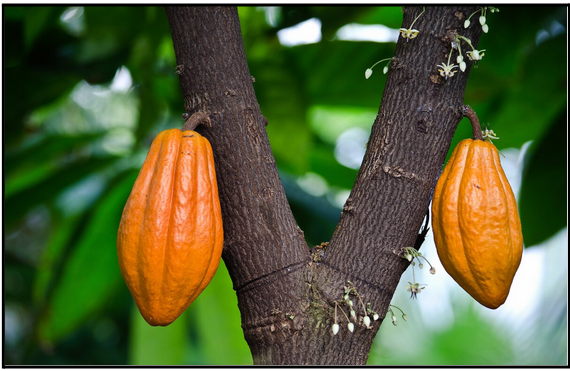GS3-Economy
Why in the news
A scarcity of cocoa beans has resulted in a near cessation of operations in processing facilities in Ivory Coast and Ghana, the two nations accounting for 60% of worldwide production.
About the Cocoa Production
About
- Cocoa refers to the dried and partially fermented fatty seed of the cacao tree, utilised in making chocolate.
- Cocoa powder is the dry powder produced by grinding cocoa seeds and removing cocoa butter from the dark, bitter cocoa solids.
- Cocoa solids are the component of the cacao seed, cocoa butter is the fat component, and chocolate is the combination of both.
Production Conditions
- Grown up to 300 m above sea level.
- Requires a minimum of 90-100 mm rainfall per month, with an annual rainfall of 1500-2000 mm.
- Equitable climate with well-distributed rainfall is essential. Irrigation may be necessary during prolonged dry periods.
- Ideal temperature range of 15°-39°C, with 25°C being optimum.
Soil Requirements
- Requires deep and well-drained soils; poorly drained soil hampers plant growth.
- Predominantly cultivated in clay loam and sandy loam soils.
- Thrives in soil pH range of 6.5 to 7.0.
Shade Requirement
- Originally evolved as an under-storey crop in Amazonian forests.
- Commercial cultivation requires approximately 50 percent of available light.
Major Producing Regions
- Africa: Côte d'Ivoire and Ghana are the top producers, along with Cameroon and Nigeria.
- Southeast Asia: Indonesia and Malaysia.
- Latin America: Ecuador, Brazil, and Peru.
Reasons for Declining Cocoa Production in West Africa
The global market for chocolate and chocolate products is experiencing rapid growth, projected to exceed 4% annually in the coming years. This increasing demand for cocoa highlights the critical need to address the intertwined sustainability issues facing the industry.
- Environmental Factors
- Impact of El Niño weather phenomenon leading to drier weather in West Africa.
- Contributes to problems such as swollen shoot virus disease on farms.
- Ghana has lost harvests from nearly 500,000 hectares of land due to these factors.
- Economic Cycle of Cocoa Production
- Inherent patterns of expansion and contraction in cocoa farming.
- Ageing cocoa trees become susceptible to diseases, requiring high maintenance costs.
- Historical trend of farmers abandoning old farms and starting anew in fresh forests.
- Difficulty in finding new forests due to increasing scarcity.
- Lack of fair compensation for sustainable cocoa production exacerbates the issue.
- Human Factors
- mining activities degrade the quality of the land, rendering it unsuitable for cocoa cultivation.
Impact on Cocoa Farmers and Cocoa-Producing Countries' Economies
- Farm Level Impact
- Despite rising cocoa prices, farmers are not significantly benefitting due to decreased output, resulting in fewer harvests and overall lower earnings.
- Economic challenges like high inflation and currency devaluation in west Africa, especially in Ghana, have exacerbated the situation, leading to increased poverty among farmers.
- Reduction in Local Processing
- Decline in cocoa output has led to a reduction in local processing activities.
- Major African processing facilities in Ivory Coast and Ghana have either ceased operations or reduced processing capacity due to inability to purchase beans.
- Global Chocolate Prices
- Reduced cocoa supply is likely to cause a surge in chocolate prices worldwide.
- This poses challenges for emerging local production units in cocoa-producing countries.
- Bargaining Power of Cocoa-Producing Countries
- Despite the challenges, cocoa-producing countries in west Africa may have increased bargaining power.
- This presents an opportunity for these nations to unite and negotiate more favourable terms for their cocoa farmers.
Impact on Chocolate Makers and Cocoa Alternatives
- Unsustainability of Cocoa Cultivation
- The current situation highlights the unsustainability of continuing cocoa cultivation under prevailing conditions.
- Emergence of Cocoa Alternatives
- Companies like Planet A Foods are pioneering the development of cocoa-free chocolate alternatives.
- These alternatives utilise technology to transform ingredients such as oats and sunflower seeds into substitutes for cocoa mass and butter.
- Benefits for All
- Cocoa alternatives offer benefits to both consumers and the environment.
- Reduced demand for cocoa can mitigate issues like mass deforestation and significant carbon emissions associated with cocoa cultivation.
- Moreover, the exploration of cocoa alternatives can address concerns related to labor abuses in the cocoa industry.
- Role in Sustainable Solutions
- Exploring cocoa alternatives is seen as part of the solution to address the environmental and social challenges posed by traditional cocoa cultivation.
- This shift towards cocoa alternatives aligns with the growing awareness of sustainability issues and the need for responsible consumption practices.
|
Cocoa Production in India Suitable Plantation Crop
Cocoa Cultivation in India
|
Conclusion
The current state of cocoa production, particularly in West Africa, underscores the complex challenges faced by both cocoa farmers and cocoa-producing countries. Environmental factors such as the impact of El Niño, coupled with economic cycles and human-related issues, have significantly contributed to declining cocoa output. This has led to adverse effects on farmers' livelihoods, local processing activities, and global chocolate prices. However, the emergence of cocoa alternatives, along with increased bargaining power for cocoa-producing nations, presents opportunities for sustainable solutions. Moreover, India's growing cocoa cultivation, particularly in states like Andhra Pradesh, highlights the potential for diversifying cocoa production and addressing global supply chain challenges.

